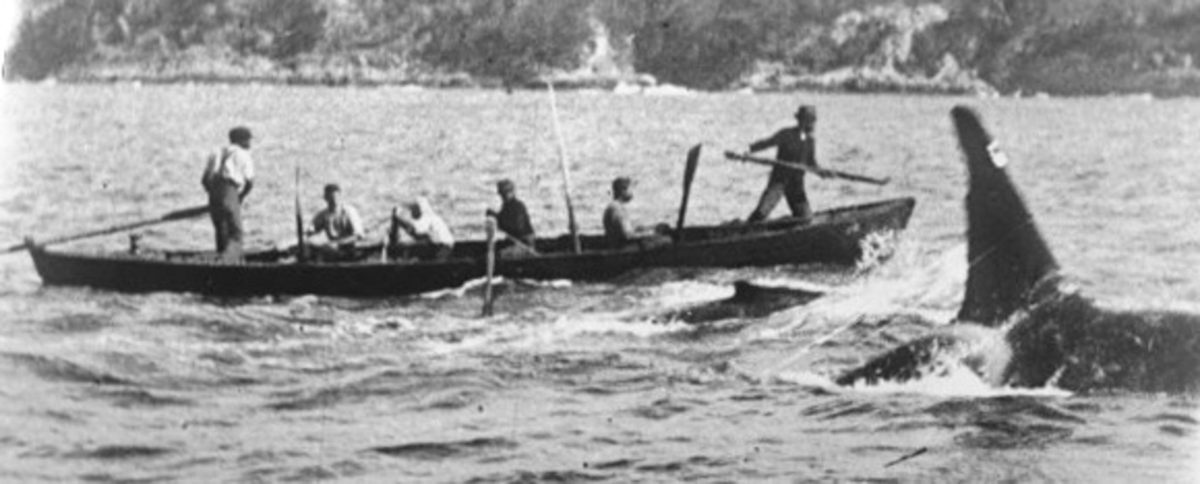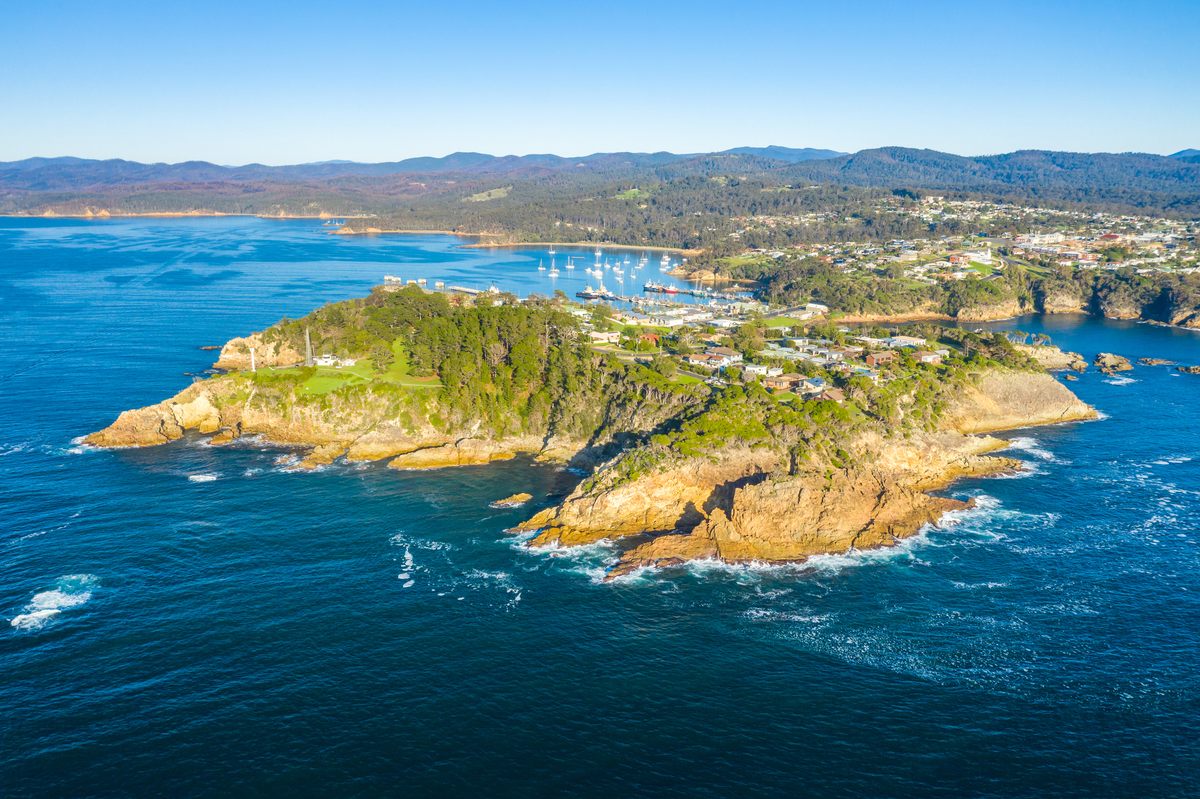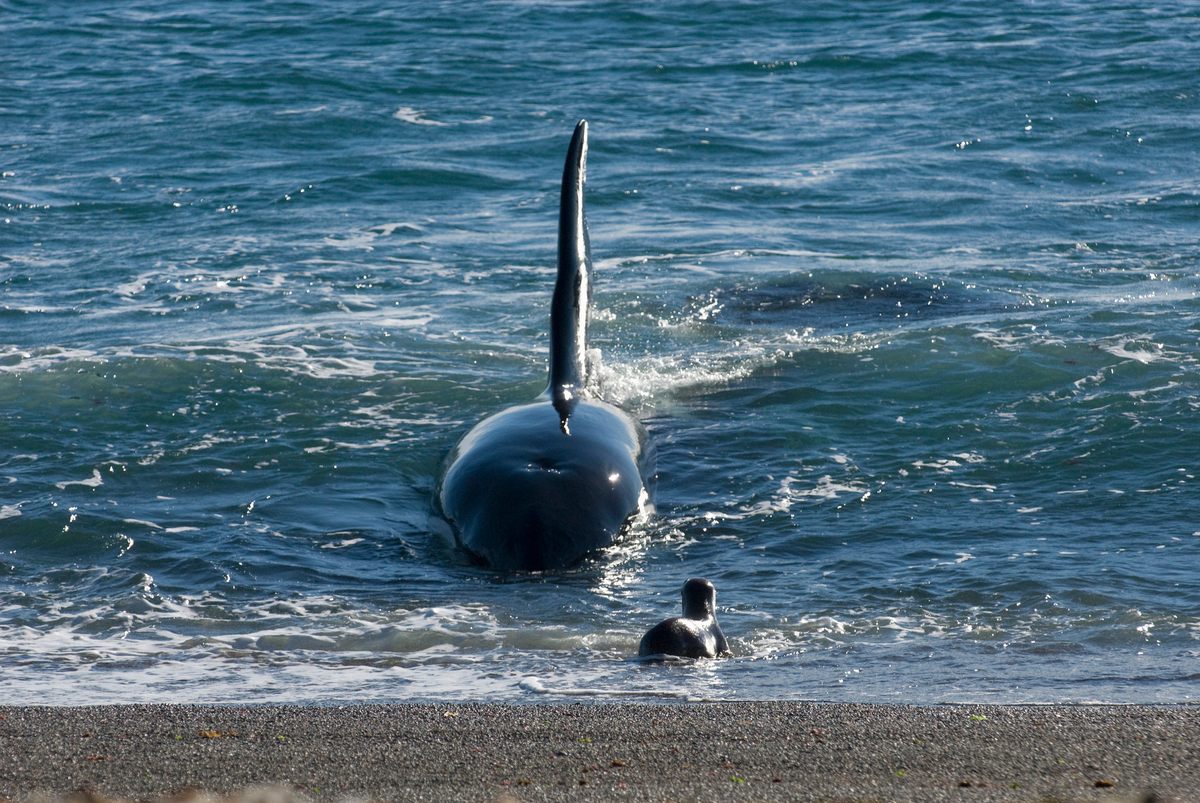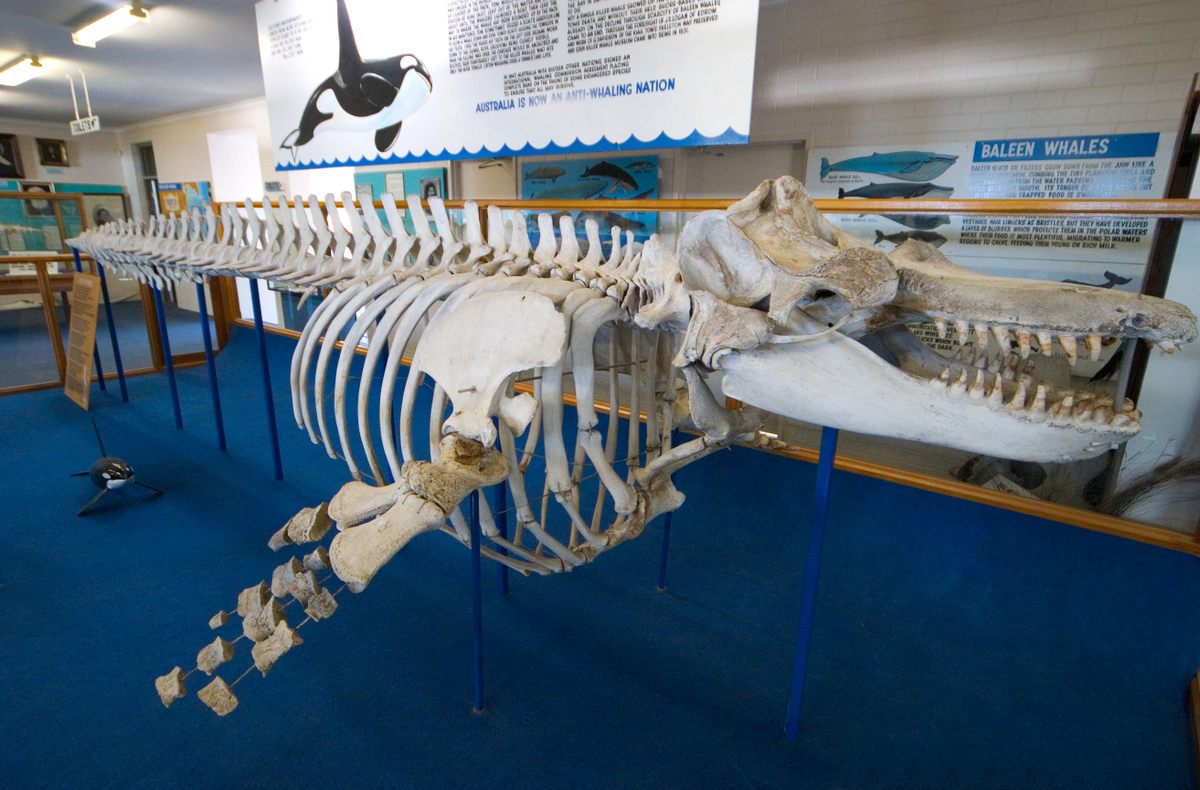The Killer Whales of Eden and the ‘Law of the Tongue’
Orcas and humans once hunted together in southeastern Australia, until their millennia-old relationship broke down.
When a familiar siren blares through the small town of Eden on the coast of New South Wales, Australia, people start to gather. It’s not a warning of a tsunami or other disaster, but for a far more pleasant occurrence: a whale sighting.
Occasionally, a baleen whale, such as a humpback, strays from the migratory superhighway off the coast and into Twofold Bay in Eden. The alarm atop the tiny town’s killer whale museum is sounded to notify the town’s 3,000 or so residents and any tourists to this scenic stretch of coastline. Over 150 years ago, the town hosted a different marine show. Orcas, or killer whales, the largest of the dolphin family, used to visit this bay every winter, and were vital to a unique way of life in Eden. Humans didn’t just watch the orcas, but rather worked side by side with them to take down some of the ocean’s largest creatures.
“It’s just part of our fabric,” says historian Jenny Drenkhahn, who grew up in the town and has worked at the Eden Killer Whale Museum for over 40 years. “But most people are just in awe of the true story of how they cooperated and how they had this relationship with people, whether they be Indigenous or Europeans later on.”
In the 1860s, killer whales struck a kind of deal with European whalers in Eden, one that the coastal Thaua people*—part of the Aboriginal Yuin Nation—had laid the groundwork for thousands of years. With the guidance of Thaua crew members, the whalers went from treating the orcas as pests to seeing them as partners, under what came to be known as the “Law of the Tongue,” in which orcas would help the whalers find and catch larger baleen whales, in exchange for their favorite parts: the lips and tongue. The deal went swimmingly, it seems, until, it is said, white whalers ruined it.

“They [the Thaua and killer whales] had this really good relationship long before the whaling,” said Lynne Thomas, daughter of Yuin elder Guboo Ted Thomas, in an interview with the Australian Broadcasting Corporation (ABC) in 2014. “That relationship was very strong, not only through working as a whaleman down there at Twofold Bay, but also culturally, because they’re part of our dreaming stories.” In Australian Aboriginal cultures, Dreamtime stories explain how things came to be.
“We consider beowas [killer whales] to be our brothers,” writes Thaua traditional custodian Steven Holmes in a foreword for a new study on Eden’s orcas in the Journal of Heredity. “In Australian Aboriginal cultures, Dreamtime stories explain how things came to be. The Thaua’s Dreamtime stories say that when a Thaua member dies, they are reincarnated as a beowa. The beowas remained part of the Thaua, even after passing.”
While non-Indigenous researchers had previously concluded that the Thaua had only opportunistically taken beached whales left by orcas, Holmes clarifies that the Thaua have been actively working with the local orcas for millennia. The Thaua followed their own Law of the Tongue, leaving the killer whale’s favorite morsels after the pods chased baleen whales into the bay for Thaua to hunt. But according to Holmes, the relationship was more than transactional. “My people had a long-lasting friendship with the beowa in Eden,” writes Holmes. He recalls his grandmother’s stories of a blind man who would walk up and down the beach singing to the killer whales, and that they would swim alongside him, talking back.*

For a long time, the Aboriginal history was left out of the story of Eden’s killer whales, says zoologist Danielle Clode at Flinders University in Australia, who spent years digging up the truth behind these stories for her 2002 book, Killers in Eden. “There was no mention of Aboriginal people whatsoever. It was a purely white story, [like] they arrived and trained the killer whales like sheep dogs.” But now, the museum, historians, and other researchers are beginning to center the role of the Thaua.
“If it hadn’t been for the Indigenous crews on those boats, I don’t think that that relationship would have evolved,” says Clode. “And the Europeans would have just killed the killer whales because they were getting in the way.”
Thaua crew members insisted the orcas be spared, and showed the Europeans that they could be an asset, explained Thomas. More than an asset, a partner, Clode adds. Through her research, she concluded that the orcas weren’t just working side by side with the whalers, but actively collaborating, as the locals’ and museum’s stories say. Four remaining eyewitnesses explained how the hunts went in a 2004 interview in an ABC documentary based on Clode’s book. The orcas cornered whales in the shallow bay and sent scouts to the whaling station to signal the men it was time to hunt. The orcas would then guide them to the trapped whale, and wait for their reward. Once the whale was harpooned and killed, the whalers would let the body sink, so orcas could feast on the lips and tongue. Once the body bloated a bit and floated, the whalers could pull it ashore.

“Even though it may appear to be far-fetched, it happened in front of my eyes, and there’s so much evidence here in Eden,” said Douglas Ireland in the documentary. The whalers even found they could fish the rough seas at night, guided by the fearless pods, he went on. “It’s quite a high level of trust that those whalers put into the killer whales to guide them and not to lead them astray,” says Clode. “And there’s plenty of reports of the killer whales guiding them very explicitly.”
Now the museum relies on records from the period. “We’re definitely out of the realm of having eyewitnesses,” says the Eden historian Drenkhahn. “Still, there’s a lot of written documentation of all these little tales here.” Toward the end of the whaling days, whalers and locals started photographing and writing about their interactions, keeping these stories alive.
According to local accounts, photos, and written records, a large male whale they called Old Tom was particularly keen on humans. He alerted the whalers to nearby targets by splashing and thrashing. He was known to be playful with humans, and to drag boats around the bay by their lines—not unheard of behavior from an orca, Clode says. Holmes recalls his grandmother’s stories of her great grandfather and other Thaua actually riding Old Tom by holding his dorsal fin.* There are many other tales of the orcas’ assistance, from guarding the boats from sharks to even helping recover a dead fisherman’s body.
Orcas are not only intelligent, but playful and emotional. Over the years, human relationships with orcas have shifted from Indigenous interaction and worship, to the surge in captive performing whales in the 1960s and 1970s, to more recent reports of orcas ramming motors and sinking boats in the Mediterranean Sea. The story of Eden may help explain why orcas are making a ruckus today.
“When you have a highly intelligent, social, and adaptable hunter like an orca—or like humans—they come up with weird behaviors every now and again,” says Clode. “They have different cultures, and we see that in killer whales across the world.” Clode points to orcas that hunt seals off the beach or those in Canada that wore dead salmon as hats. “We’re pretty good at doing stupid trends,” says Clode. “So I don’t think we should be criticizing them.”

That tendency toward culture, including matriarchal whale society, could have contributed to the end of the Twofold Bay relationship. In 1901, one of the orcas beached on the shore. Legend says a drunk man named J.R. Logan stabbed the whale. The townspeople were outraged. Some say the Thaua left the whaling station in Eden after the betrayal of their ancestors, but it’s unclear how many Thaua left at this time and for what combination of reasons.
The whales reacted, too. Most orcas didn’t return the next year, and eventually only Old Tom and a couple other males stayed behind, says Clode. It’s hard to say for sure what kept the whales away. Clode suspects there was a decline in prey due to major whaling operations off the coast, but she doesn’t discount emotional betrayal. “It’s not uncommon for killer whales to react like that to deaths,” says Clode. “They do leave the area where it happened. And the resources were declining … perhaps there just weren’t enough whales to support that big pod.”
In 1930, Old Tom was only one of a couple orcas left in the bay. On September 17, his body washed ashore. It was thought he may have starved to death, as his stomach was empty, and he had a dental abscess that might have contributed to an inability to hunt. The ABC documentary crew found a recorded interview from 1998, with a woman who told a much first-hand account of Old Tom’s demise that adds a dark wrinkle.
“You can believe this story or not, but it’s dead true, because I was there,” said Margaret Brooks, daughter of Logan, the man suspected of harming the whale on the beach. As the baleen whale numbers dwindled, Logan and another whaler, accompanied by Brooks, pulled in a catch without offering Old Tom his tribute. The orca fought back and lost a couple of teeth as he tugged on the boat’s line—perhaps leading to a fatal abscess. That was the last the town saw of its famous orcas. The whaling industry was not far behind.

Many have long wondered where the pod went after Twofold Bay, and if their relatives are still around today. Now, an international team of researchers is investigating the mystery, with the help of Old Tom.
Lead author and marine ecologist Isabella Reeves, a doctoral candidate at Flinders University and the Cetacean Research Centre in Western Australia, worked with Holmes to make sure the Thaua people’s history was highlighted in the new research paper. In pursuit of the next page in the Eden orcas’ story, the team sequenced the DNA of Old Tom from a tooth in his skeleton, which is housed in the orca museum today.
Comparing Old Tom’s DNA to genetic material from orcas all over the world, the team couldn’t find any close relations among modern pods today. Unfortunately, this means the famed orcas may have gone locally extinct, and left no clear living lineage. “Each new generation within a population leaves a footprint, and the further you go back in time the smaller the footprint of the ancestors become, but remnants will remain in the contemporary animals” says Reeves. “While we can’t say for certain, our data encompassed a lot of killer whales from a variety of geographic regions—each rich with thousands of years worth of their ancestry. So if we were going to find any footprints of the lineage existing today, we probably would have found evidence for it.”
This work emphasizes how much orca populations have shifted over time, says Reeves: “Killer whales today are not necessarily what they were 100 years ago. Things change, the environment changes, and we change—and as such, so do they.”

What exactly happened all those years ago will remain a mystery, says Reeves. “Unless there’s very advanced technology that comes out in the future, I do not think we’ll ever get any more DNA from Tom,” she says. “So I think a lot of the secrets will be held at bay, and that’s probably where they deserve to be.”
Reeves believes that we can learn not just from the orca DNA, but from this unique relationship between human and orca. “I think the biggest lesson to be learned is surrounding interspecies cooperation and learning to coexist between the land and the people,” says Reeves. “Perhaps if learned earlier, we would not be facing many of the challenges we are facing today, especially in relation to overexploitation of the natural environment.”
Though the orcas of old are long gone from Eden, their memory lives on in the museum and the passing of stories. “For the Thaua, this was a special time to be alive,” writes Holmes. “A part of our history that was passed on from generation to generation. I hope one day I am able to reconnect with beowas.”*
* A version of this story originally appeared on August 1, 2023. It was updated in October 2023 with the latest research findings from Isabella Reeves and her international research team, and the cultural insights of Thaua traditional custodian Steven Holmes.
This story originally ran in 2023; it has been updated for 2023.










































Follow us on Twitter to get the latest on the world's hidden wonders.
Like us on Facebook to get the latest on the world's hidden wonders.
Follow us on Twitter Like us on Facebook